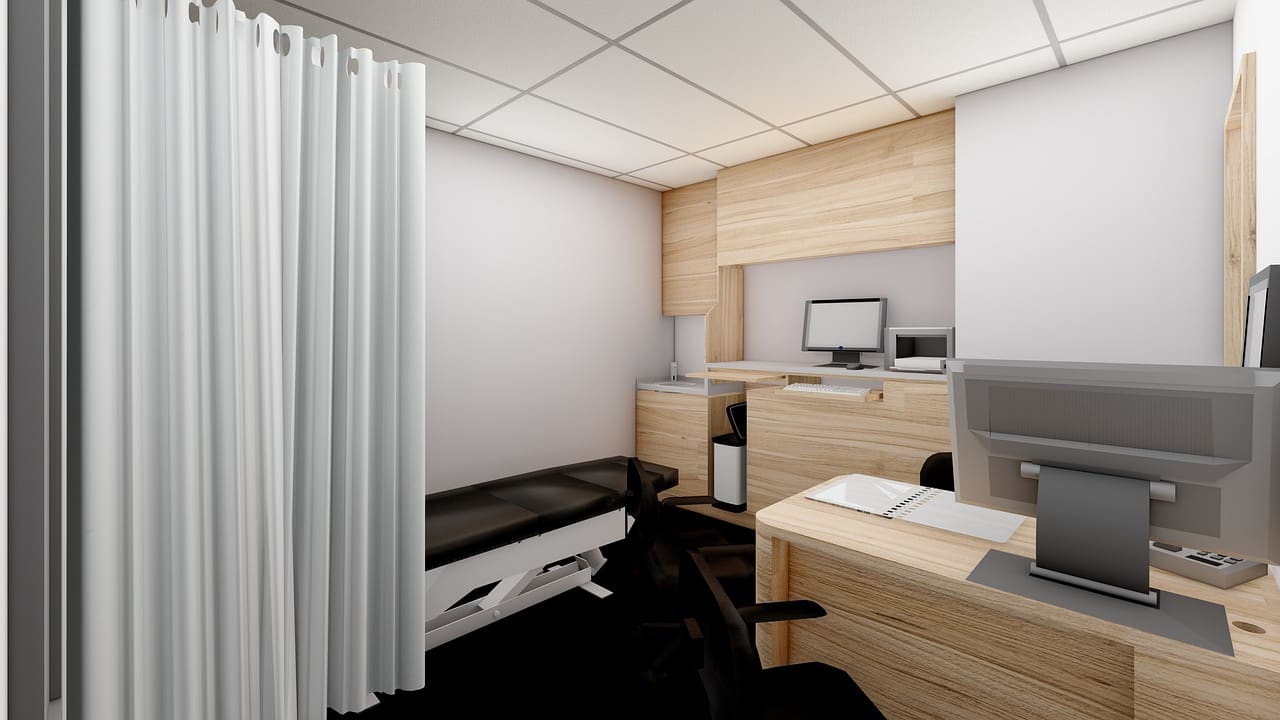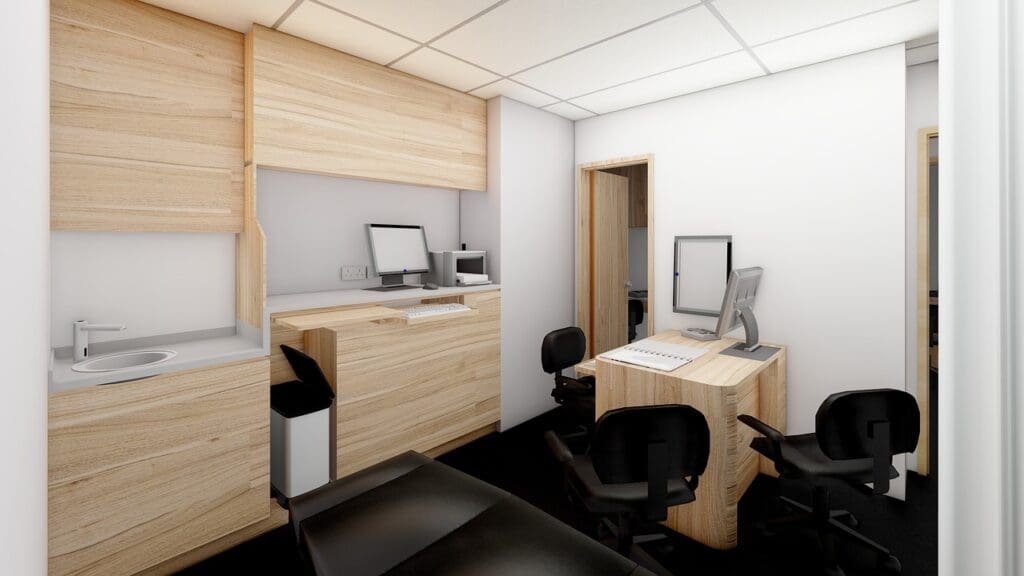Comfort Meets Care: 8 Ways to Choose Healthcare Office Furniture
Patients’ comfort and well-being should be paramount. One crucial yet often overlooked aspect of this experience is healthcare office furniture within the healthcare office. The right furniture enhances the ambiance and plays a significant role in ensuring patient comfort and staff efficiency. Here are eight essential tips to consider when choosing healthcare office furniture:


Table of Contents
Key Takeaways
- Comfort in healthcare furniture reduces patient anxiety and staff strain.
- Durable and cleanable furniture supports safety and long-term use efficiency.
- Space-efficient furniture maximizes healthcare environments for better patient flow.
- Aesthetically pleasing furniture creates a welcoming and therapeutic healthcare atmosphere.
- Accessibility and flexibility in furniture ensure inclusivity for all patients.
- Technology-integrated furniture enhances healthcare efficiency and supports modern care practices.
- Adhering to safety standards in furniture selection protects patients and staff.
- Planning for future furniture needs ensures adaptability and cost-effectiveness.
Tip 1: Prioritize Comfort
When selecting healthcare office furniture, comfort should be a top priority for patients and staff. Comfortable furniture can significantly enhance the patient’s experience in a healthcare setting. For staff, ergonomic and supportive furniture is essential to prevent strain and injuries, ensuring they can perform their duties efficiently and comfortably.
To prioritize comfort when choosing healthcare office furniture, consider the following factors:
- Ergonomic Design: Select chairs and desks to support natural posture, which reduces the risk of back pain and musculoskeletal disorders.
- Adjustability: Opt for furniture that can be adjusted to fit different body sizes and preferences, ensuring comfort for a wide range of users.
- Supportive Seating: Ensure that chairs offer proper lumbar support and are cushioned to enhance comfort during prolonged periods of sitting.
- Patient Beds and Recliners: Choose beds and recliners that are easily adjustable, providing comfort and support for patients during their stay.
- Materials: Select soft yet durable materials, and consider breathable fabrics that can contribute to comfort in various temperatures.
- Accessibility: Make sure the furniture is accessible for all patients, including those with mobility challenges, so everyone can sit and rise quickly.
Tip 2: Ensure Durability and Cleanliness
Durable healthcare office furniture withstands frequent use in a healthcare environment, offering long-term savings and maintaining a professional appearance. Cleanliness is equally vital, as it directly impacts infection control efforts. Furniture that is easy to clean and disinfect can significantly reduce the spread of germs and bacteria, protecting patients and staff from healthcare-associated infections.
To ensure durability and cleanliness when choosing healthcare office furniture, follow these tips:
- High-Quality Materials: Opt for furniture made from high-quality, durable materials that can withstand constant use and cleaning, such as metal, high-impact plastic, or commercial-grade fabrics.
- Easy-to-Clean Surfaces: Choose furniture with non-porous surfaces that can be easily wiped down and disinfected without deteriorating, ensuring that cleanliness standards are maintained.
- Seamless Design: Furniture without crevices or fabric folds prevents the accumulation of dirt and germs, making cleaning easier.
- Removable Covers: Consider furniture with removable and washable covers to facilitate deep cleaning and maintain hygiene standards.
- Antimicrobial Coatings: Look for furniture treated with antimicrobial coatings to inhibit the growth of bacteria, mold, and mildew on surfaces.
- Tested for Healthcare Use: Select furniture that has been tested and approved for healthcare use, ensuring it meets the specific requirements for durability and ease of cleaning.


Tip 3: Optimize for Space Efficiency
Optimizing for space efficiency is essential, especially in environments where space is at a premium. Efficient use of space facilitates better patient flow and staff movement and contributes to a less cluttered, more organized setting.
To optimize for space efficiency when choosing healthcare office furniture in White Plains, NY, consider these actionable tips:
- Choose Multi-functional Furniture: Select pieces that serve multiple purposes, such as exam tables with built-in storage or waiting room seating with side tables. This reduces the need for additional pieces and maximizes the functional use of space.
- Utilize Vertical Space: Opt for tall, slender storage units with less floor space while providing ample storage. Wall-mounted shelves and cabinets can also free up valuable floor space.
- Implement Modular Designs: Look for furniture that can be easily reconfigured or adjusted to fit different spaces and needs. Modular workstations and movable partitions offer flexibility for changing layouts.
- Select Foldable or Stackable Options: For areas that serve multiple purposes, consider chairs and tables that can be folded or stacked when not in use, allowing for easy rearrangement and storage.
- Invest in Mobile Furniture: Choose pieces on casters for easy movement. Mobile desks, chairs, and storage units can be quickly repositioned to accommodate different functions and activities.
- Consider Size and Scale: Opt for furniture that fits the room’s scale. Oversized furniture can make a space feel cramped, while too-small pieces may need to be more practical. Measure carefully and plan layouts to ensure a good fit.
Tip 4: Consider the Aesthetics
Aesthetics in healthcare environments create a therapeutic and healing space. The right choice in healthcare office furniture can significantly contribute to creating an environment that promotes patient well-being and enhances their recovery journey. Moreover, ensuring a consistent design theme across the facility can instill a sense of calm and orderliness, essential aspects of a healthcare setting.
To ensure aesthetics are considered effectively when choosing healthcare office furniture, keep in mind the following:
- Align with Healthcare Themes: Choose furniture styles and colors that reflect the healthcare facility’s theme and ethos. Whether aiming for a modern, minimalist look or a more traditional, comforting feel, ensure that the furniture complements the overall design vision.
- Create a Welcoming Environment: Opt for furniture with warm, inviting colors and materials that can make healthcare settings less intimidating. Soft textures and rounded edges can contribute to a friendlier atmosphere.
- Incorporate Nature-Inspired Elements: Studies have shown that incorporating natural elements in healthcare design can reduce stress and improve patient outcomes. Consider furniture with natural wood finishes or colors inspired by nature.
- Consider Lighting and Color Psychology: The choice of furniture can influence the facility’s lighting and color scheme. Selecting pieces that enhance natural light or incorporating colors known for their calming effects can create a more soothing environment.
- Customize Where Possible: Tailoring furniture choices to the specific needs and identity of the healthcare facility can reinforce branding and create a unique patient experience. Custom upholstery or finishes can add a personal touch that differentiates your environment.


Tip 5: Focus on Accessibility and Flexibility
Accessibility and flexibility in healthcare office furniture are about inclusivity and adaptability. Ensuring that furniture meets the needs of all patients, including those with mobility challenges, is a fundamental aspect of healthcare. Similarly, flexible furniture solutions offer the adaptability needed to accommodate a wide range of patient needs and healthcare activities.
Here are key strategies to ensure accessibility and flexibility in healthcare office furniture:
- Meet ADA Standards: Choose furniture that complies with the Americans with Disabilities Act (ADA) standards, ensuring accessibility for individuals with disabilities. This includes considering the height of tables and desks, the ease of chair access, and the clearance for wheelchairs and walkers.
- Incorporate Height-Adjustable Features: Opt for desks, tables, and counters that can be adjusted in height to accommodate both standing and seated positions and to be accessible for wheelchair users.
- Select Easily Movable Furniture: Look for furniture with casters or lightweight designs that can be easily moved or reconfigured. This flexibility allows for quick adjustments to the layout as needed to serve patients and staff better.
- Choose Versatile Seating Options: Invest in seating that can be used in various areas of the facility, from waiting rooms to patient rooms, and that accommodates a wide range of body types and mobility levels.
Tip 6: Factor in Technology Integration
Healthcare office furniture must evolve to support technology integration, ensuring the environment fully accommodates the digital tools essential for patient care. Furniture that facilitates the use of electronic health records (EHRs), telemedicine, and other technological advancements can significantly enhance efficiency and accuracy in patient care.
Here are crucial considerations for integrating technology with healthcare office furniture:
- Built-in Power Outlets: Select desks and seating with integrated power outlets to ensure electronic devices can be easily charged and used throughout the healthcare facility. This minimizes the need for extension cords, which can be tripping hazards.
- Effective Cable Management Systems: Look for furniture designed with cable management in mind to keep workspaces tidy and safe. Proper cable management prevents accidents and maintains a professional appearance.
- Adjustable Monitor Arms: Choose furniture that can accommodate or is compatible with adjustable monitor arms. This allows screens to be positioned at the optimal height and angle, reducing the risk of neck and eye strain.
- Seating with Device Holders: Opt for seating solutions that include built-in holders for tablets or mobile devices. This is particularly useful in waiting areas or patient consultation rooms, where patients or staff may need to access digital information.
- Tech-Integrated Workstations: Consider workstations that seamlessly integrate technology, including spaces for printers, scanners, and other peripherals. These stations should offer easy access to power and data ports.
- Secure Storage for Technology: Ensure secure, ventilated storage for technological equipment when not in use. Lockable cabinets with ventilation can protect sensitive equipment from theft and overheating.
Tip 7: Ensure Safety Standards
Safety is paramount in healthcare settings, where the well-being of patients and staff is the primary concern. Healthcare office furniture must adhere to stringent safety standards to minimize risks and ensure a secure environment. This commitment to safety involves selecting furniture made from non-toxic materials, designed to prevent injuries, and capable of supporting the health and safety of all users.
Here are essential guidelines to ensure that healthcare office furniture meets the highest safety standards:
- Choose Non-toxic Materials: Select furniture made from materials that do not emit harmful chemicals or volatile organic compounds (VOCs). This is especially important in healthcare settings, where patients may have heightened sensitivities or compromised immune systems.
- Avoid Sharp Edges: Opt for furniture with rounded edges and corners to reduce the risk of injuries from bumps or falls. This simple design choice can significantly decrease the likelihood of accidents in fast-paced healthcare environments.
- Ensure Stability: Choose stable and sturdy furniture that is unlikely to tip over. This is particularly crucial for shelving units, patient beds, and examination tables.
- Incorporate Safety Features: Look for furniture with additional safety features, such as lockable wheels on mobile units, anti-slip surfaces on step stools, and child-proof locks on storage units.
- Select Flame-Retardant Fabrics: For furniture that includes upholstery, opt for flame-retardant fabrics to reduce fire hazards. This is a critical consideration in environments where electronic equipment is in use.


Tip 8: Plan for Future Needs
The healthcare industry is constantly evolving, driven by technological advancements, changing patient demographics, and shifts in healthcare practices. As such, selecting healthcare office furniture must be forward-thinking, ensuring that investments made today remain relevant and functional. Planning for the adaptability and scalability of furniture is crucial for accommodating growth and changes in healthcare delivery.
Consider these strategies to ensure your healthcare office furniture can meet future needs:
- Focus on Patient Privacy: Choose furniture solutions that enhance patient privacy, such as sound-absorbing panels or privacy screens. As healthcare delivery models evolve, ensuring patient confidentiality remains paramount, and your furniture choices can play a significant role in achieving this.
- Consider Scalability: Select furniture that can be added to or expanded upon as the facility grows. This might include adding components to modular systems or choosing designs that are part of a larger collection for easy matching in the future.
- Flexible Financial Planning: While budget considerations are crucial, investing in quality, adaptable furniture can result in significant long-term savings. Furniture that can adapt to future changes reduces the need for costly renovations or replacements.
Why Choosing the Right Healthcare Furniture Matters
Choosing the right healthcare office furniture is essential for several reasons. First, it significantly impacts the patient experience by making the environment more welcoming and less intimidating. A study found that a relaxed healthcare atmosphere can reduce patient anxiety.
Furthermore, healthcare staff efficiency benefits from furniture designed for their needs, as it reduces the risk of work-related injuries and increases job satisfaction. For example, ergonomic chairs and desks can reduce the likelihood of developing musculoskeletal disorders, which is a common occupational health issue.
Lastly, safety and accessibility are paramount. Furniture must comply with the Americans with Disabilities Act (ADA) standards to ensure access for all patients, including those with disabilities.
FAQs
How often should healthcare office furniture be replaced?
Generally, it is advisable to consider replacing furniture every 7-10 years to ensure it maintains the highest safety, functionality, and aesthetics standards. Regular assessments help identify wear and tear that compromise safety or comfort, ensuring the healthcare environment remains welcoming and secure for patients and staff.
Can healthcare office furniture improve patient satisfaction?
Absolutely. The design and comfort of healthcare office furniture play a crucial role in shaping patient experiences. Comfortable seating in waiting areas, accessible and ergonomic furniture in treatment rooms, and aesthetically pleasing environments can significantly reduce patient stress and anxiety. These elements contribute to a more positive healthcare experience, improving patient satisfaction.
What’s the most crucial factor in choosing healthcare office furniture?
While each factor—such as durability, cleanliness, and aesthetics—plays a vital role, prioritizing patient and staff comfort and safety is paramount. Furniture that supports the physical well-being of patients and staff, adheres to safety standards, and is accessible to individuals of all abilities is essential. Ensuring the healthcare environment is safe and comfortable directly impacts the quality of care and the efficiency of healthcare services.
How does furniture choice impact healthcare staff performance?
The furniture in a healthcare setting can significantly impact staff performance and morale. Ergonomic designs that reduce the risk of musculoskeletal injuries can enhance staff well-being and productivity. Additionally, furniture that integrates technology can streamline workflow, making accessing patient records more efficient. The right furniture choices can lead to a more organized, efficient, and positive working environment, benefiting healthcare professionals and improving patient care.
Is there a difference between regular office furniture and healthcare office furniture?
Yes, there are significant differences between regular office furniture and healthcare office furniture. Healthcare furniture is specifically designed to meet the unique needs of medical environments, including durability for high-usage areas, ease of cleaning for infection control, and ergonomic features for patient and staff comfort. Additionally, healthcare furniture often incorporates features for accessibility and safety, such as adjustable heights and rounded edges, and is built to withstand the rigorous cleaning protocols necessary in healthcare settings.


Elevate Your Healthcare Environment with Stamford Office Furniture
Selecting the right healthcare office furniture is crucial for ensuring patient comfort, staff efficiency, and overall safety within any White Plains, NY healthcare setting. Stamford Office Furniture offers an extensive range of high-quality, adaptable, and aesthetically pleasing furniture options designed to meet the diverse needs of healthcare facilities. Our commitment to durability, functionality, and design excellence makes them an ideal partner for creating healing environments. Contact us now to explore our solutions and transform your space!





































